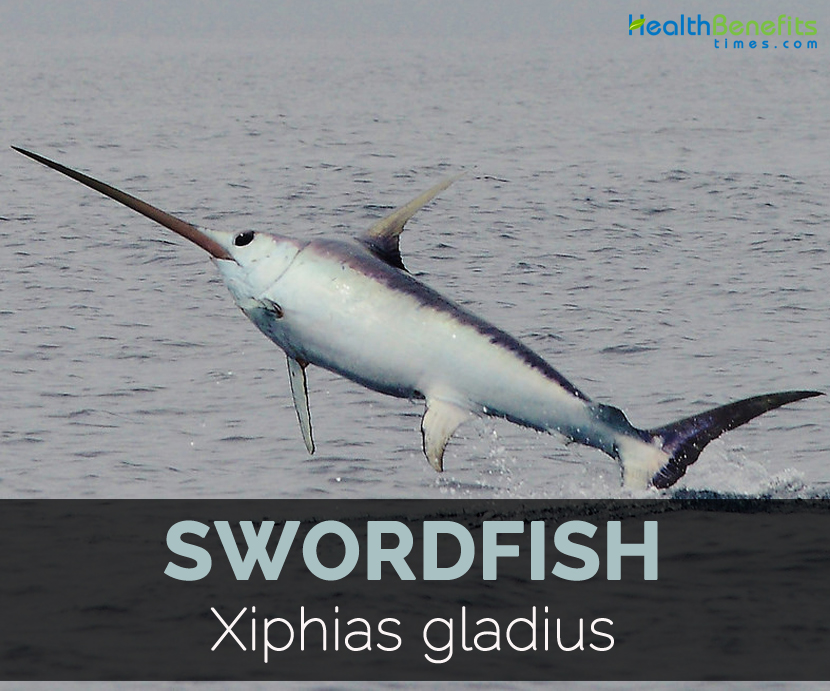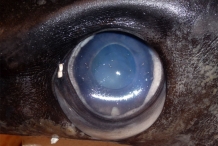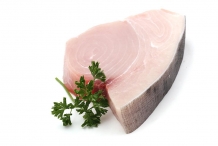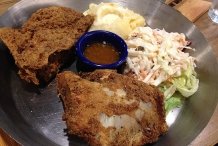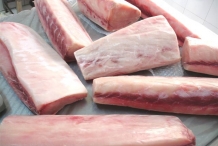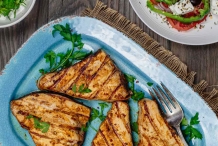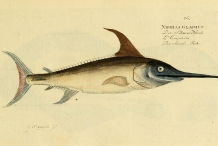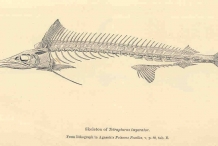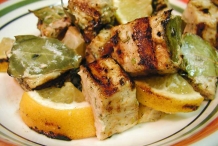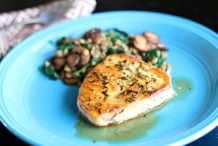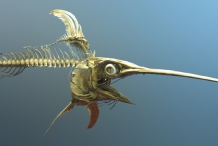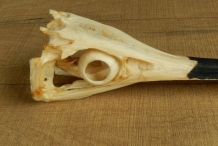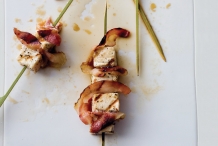| Swordfish Quick Facts |
| Name: |
Swordfish |
| Scientific Name: |
Xiphias gladius |
| Colors |
Blackish-brown |
| Shapes |
Elongate, rounded; 3 m (9.8 ft) in length |
| Flesh colors |
White or ivory to pink or orange |
| Taste |
Slightly sweet |
| Calories |
182 Kcal./cup |
| Major nutrients |
Selenium (132.00%)
Vitamin D (117.33%)
Vitamin B-12 (71.67%)
Isoleucine (68.96%)
Lysine (68.72%)
|
| Health benefits |
Vitamin B complex, Strengthen bones, Heart health, Muscle health, Rich in protein |
Swordfish, also called broadbills, are large and highly migratory or predatory fish identifying by long and flat bill. It is a well-known billfish category though elusive. It is round-bodied, elongated and lose all teeth or scales by adulthood. It is widely found in temperate and tropical parts of Atlantic, Indian and Pacific Oceans and typically found from near surface to depth of 550 m (1,800 ft). Usually, it measures 3 m (9.8 ft) in length and the maximum length reported is 4.55 m (14.9 ft) weighing 650 kg (1,430 lb) in weight.
It is the exclusive member of family Xiphiidae. They are formidable predators. It has acute eyesight which helps them to address prey and its flesh comprises of white muscle providing energy for sudden bursts of activity when chased their prey. Then swordfish uses its bill to impale or stun its victim, lacerate it into pieces or might swallow it whole. It feeds during the day mainly on squid but also fish and crustaceans infrequently. It undertakes vertical migrations in ocean and follows the movement of small fish, shrimp and squid which moves with changing intensity of light for avoiding predators. It is unable to maintain higher body temperature than the temperature of surrounding water. But they have uncommon muscle and brown tissue which warms blood flowing to eyes and brain that helps to enable to tolerate extreme cold of ocean depths. They undertake lengthy seasonal migrations, to cold or temperate waters in summer where it feed and return back to warm waters for spawning in autumn.
The spawning occurs year round in warm equatorial waters and it occurs in cooler regions in spring and summer. The finest spawning grounds are found in Mediterranean sea, Sicily and south of the Italian Peninsula. Eggs are found from June to September and juveniles occur throughout Mediterranean from November to March. The fertilization is external. Female releases buoyant eggs in millions into water which are fertilized by sperm secreted by male. Larvae hatches from fertilized eggs. At the first year of life, larvae grow at exceptional rate reaching 90 centimeters long. Female reaches maturity at 150 centimeters and male around 100 centimeters.
Description
It is the fast swimming predator with flat, long and sword like bill used to impale and slash its prey. It has long and cylindrical blackish-brown body fading gradually to light brown underside. Body tapers to large anal fins along with high dorsal fin enabling efficient cruising. Adult are scaleless and has no teeth. Females live longer and grow larger in comparison to males.
Reproduction
Throughout the year, spawning occurs in equatorial water but at higher latitudes during spring and summer. As external fertilization takes place, solitary males and female pair during spawning. The egg varies from and 29 million in a 2,72,000 g female and 1 million to 16 million in 1,68,000 g female. The spawning occurs in the Atlantic Ocean at depths between 0 and 75 m with temperatures around 23 °C and salinity of 33.8 to 37.4 ppt. But in Pacific Ocean spawning occurs in water having temperature of 24°C or more.
Health Benefits of Swordfish
Let us discuss on the health benefits that Swordfish offers:
- Vitamin B complex
Vitamin B complex assists in converting food into energy, production of red blood cells and maintaining efficient metabolism. The serving size of 3 ounce grants 36% of daily value of Vitamin B6 and nearly 50% of niacin or Vitamin B12. Moreover, it contains 5.2% of regular amount of thiamine and riboflavin.
- Strengthen bones
The diet rich in calcium strengthen bones and teeth. Consume swordfish steak with source of calcium such as tofu, cheese and milk to achieve the desired intake. Additionally, swordfish has high content of fat soluble nutrient Vitamin D that makes the body able to absorb calcium. The diet rich in calcium but low in Vitamin D still poses risk of brittle, misshapen and thin bones.
- Heart health
A 3 ounce of serving swordfish grants 21.7 grams of protein, 7.2 grams of fat, and 148.6 calories (62 are from fat). Saturated fat also known as unhealthy fat is limited about 1/5 of the total fat content. Saturated fat causes buildup of plaque in arteries. The other fats are heart healthy monounsaturated and polyunsaturated fats lowering the chances of heart attack and stroke. It has 648 mg of DHA (docosahexaenoic acid) and 104 mg of EPA (eicosapentaenoic acid).
- Muscle health
Swordfish has high content of potassium which is an essential mineral or electrolyte critical for proper functioning of nerves and muscles. Its single serving provides 712 mg of potassium. The diet with high potassium food helps to protect heart attack and stroke.
- Rich in protein
Swordfish has high content of protein offering 33.5 grams per 6 ounce serving. Protein is essential to maintain healthy hair, skin and muscles, producing enzymes and transporting oxygen. It also has essential amino acids that are essential for the body as it could not be self-produced. It is required to lower inflammation and reducing the chances of arthritis, heart disease and cancers.
- Counteract free radical damage
A single serving of Swordfish contains 92 micrograms that enhance the function of thyroid gland and counteract free radicals.
- Sound sleep
Swordfish is rich in magnesium that lowers sleep disorders. Magnesium provides soothing effect on muscles and provides sound sleep. It also promotes duration and quality of sleep.
- Normalize blood pressure
Swordfish is an excellent source of omega-3 fatty acids with good amounts of omega-6 that lowers inflammation and maintains normal blood pressure. The regulation of blood pressure reduces strain on cardiovascular system and promotes heart health. It lowers the chances of atherosclerosis, heart attack and stroke. It contains healthy amounts of omega-3 fatty acids such as docosahexaenoic acid (DHA) and eicosapentaenoic acid (EPA).
Precautions
- Swordfish contains mercury and other toxins such as dioxins and PCBs so limit its intake.
- Children and pregnant women should avoid it because high content of mercury might cause negative impact on development of nervous system of fetus.
How to Eat
- It is grilled like steak in marinades and herbs.
- It is also consumed raw.
Other Facts
- It matures sexually at the age of five or six and has the lifespan of nine on average.
- Swordfish are cold blooded and has special organs next to its eyes which keep their eyes and brain warm in cold water.
- Mostly they consume at night.
- Large sharks, killer whales and humans are its predators.
- Generally they do not swim in schools or groups.
- It is regarded as one of the fastest fish in an ocean.
- They are carnivores and consume wide range of pelagic fish such as barracudinas, mackerel, rockfish, silver hake, latern fishes, herring and also take squid, demersal fish and crustaceans.
- It feed regularly mostly at night rising to the surface and near surface waters in search of small fish.
- Female swordfish lay from 1,000,000 and 30,000,000 eggs at a time.
References:
https://www.itis.gov/servlet/SingleRpt/SingleRpt?search_topic=TSN&search_value=172482#null
http://www.atlanticpanic.com/species/view/swordfish/
https://www.ducksters.com/animals/swordfish.php
https://oceana.org/marine-life/ocean-fishes/swordfish
http://www.chefs-resources.com/seafood/finfish/swordfish/
http://justfunfacts.com/interesting-facts-about-swordfish/
http://www.kerrash.com/is-swordfish-healthy-for-you/
https://www.foodsforbetterhealth.com/is-swordfish-healthy-35540
Comments
comments


